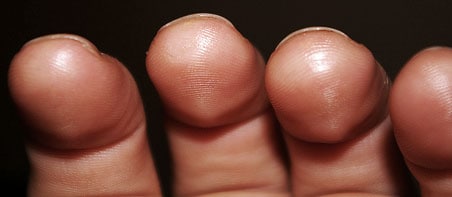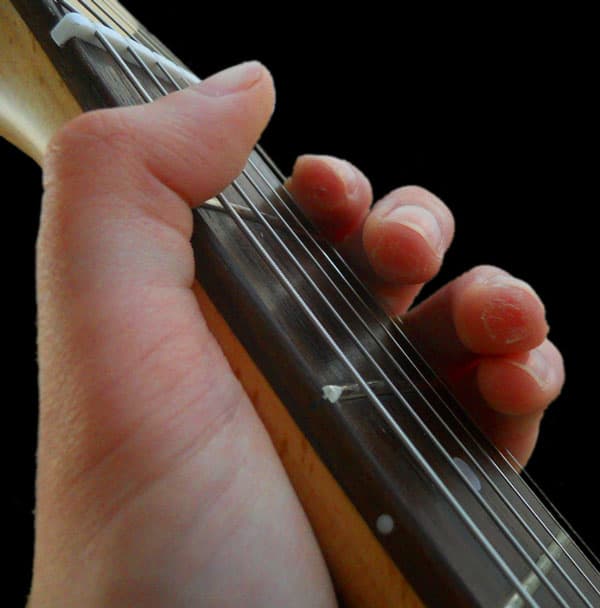TheGuitarLesson.com
This post appeared first at Best Way to Build Calluses for Guitar on TheGuitarLesson.com, thanks for reading.
Do your fingertips hurt right from playing guitar?
Don’t worry, it’s part of the learning process. Be comforted by the fact that all beginners go through this, and the pain will go away with time once your calluses develop.
Actually, after a while, you’ll get to like the feeling of soreness in your fingertip, since it’ll mean you had a good practice session.
Your newly built calluses won’t look yukky or weird at all.
Keep on reading, I’ll show you what they will eventually look like and how to get them to form quickly, so you can play guitar 24 hours a day 
What are guitar calluses?
They are areas of hardened skin on your fingertips that develop as a result of skin irritation, ie. your skin being put out to constant friction and pressure due to contact with guitar strings.
The most common callused skin people have is on their feet from walking, but guitar calluses form on your fingertips.
Are guitar calluses good for you?
Absolutely!
Before you form calluses as a newbie guitar player, your practice time will be very limited because of the pain in your fingertips. With time, practice, and callus care, your calluses will act as shields protecting you from the pain of fretting strings.
You can see what you can expect your guitar calluses to look like below. Nothing special.

Healthy guitar calluses
But until then, here are a few things you can do to quicken the buildup of calluses on your fingertips.
How to build finger calluses for guitar playing
We, as guitarists, develop calluses on our fingertips, from fretting the strings on the guitar. Here are a few tips on how to develop finger calluses faster:
- Play a lot! Ok, this is obvious, but it’s the best way to quickly build calluses. If your fingertips really hurt, that’s when you know that your calluses are developing.
-
The more it hurts, the faster calluses form. If you are feeling extra masochistic, practice on heavy gauge guitars, and do lots of bends and vibratos.
BUT know that not all pain is equal! It’s OK if your skin hurts, that’ll form the callus. But if you feel a very sharp, stinging pain, almost as if it’s coming from the bone, stop playing. That is a nerve being irritated. Give it a day of rest and it’ll pass. - Acoustic guitars with steel strings will develop calluses faster, since these strings are much harder and firmer than electric guitar strings or nylon strings. However, playing on a steel-stringed acoustic will hurt more initially. There is a trade-off with everything I guess.
- Use Eric Clapton’s secret elixir. His secret to developing calluses is dipping his fingers in rubbing alcohol. Does it work? Yes, since it dries your skin, and dry skin hardens.
- Build your calluses while not playing guitar as well. If you’re super eager to build your calluses, there is an exercise you can do on the bus, in traffic, at work, or anywhere to build them. Get your credit card, or anything with a hard, thin, solid edge, and press it against your fingertips. There are actually products for this, do a search for guitar callus builder.
Almost as important as the above, there are also a few things you should stay clear of if you want to develop calluses quickly:
-
Don’t immerse your hands in water for long. Water softens up your skin, so this means no more dishwashing without latex gloves. This also applies to washing your hair, taking showers, etc

- Don’t play after your hands are softened from water. If you get out of the tub/pool, and your fingertips are soft, the strings will shave your existing calluses right off, setting you back weeks. Don’t play your guitar until your skin has dried and has toughened up again, this usually takes about an hour.
- Don’t use hand moisturizers. Or if your hands are really dry, don’t get the moisturizer on your calluses.
- Don’t put superglue on your fingers. This is recommended by some websites, but you won’t get any benefit in terms of callus development. You will, however, smear your guitar with glue flakes and residue.
Stick to the above recommendations, and you’ll be on your way to hardening your fingertips and building those guitar calluses as quickly as possible.
How long before your guitar calluses develop?
The amount of time it takes to develop calluses on your fingers, and in turn, not have sore fingertips anymore, depends a lot on whether you do things right.
If you stick with my recommendations above, and practice at least 30 minutes per day, lengthening that as you can, you should see results pretty quickly:
- First few days of playing: Your fingers will hurt, there’s nothing you can do about it. In the first few days, you might only be able to play for 10-15 minutes, but you’ll need to increase your practice time as your fingers allow it.
- After 10 days: The very sharp pain you felt in the beginning is totally gone, and you can feel your fingertips getting harder. You still feel pressure on your fingertips when practicing, but it’s totally bearable.
- After 1 month: The pain is pretty much gone, and it doesn’t bother you anymore. Your calluses are getting harder. Sometimes a layer of skin peels of your fingertip. Don’t worry, harder skin is formed beneath. Just keep playing and whatever needs to peel off will come off by itself.

Your guitar calluses roughened up after playing
It doesn’t take long at all to develop those guitar calluses, so stick with it!
How to reduce finger pain
Everyone who learns to play the guitar has to deal with sore fingers at the beginning. There are things you can do to reduce the pain, but in turn, your calluses will form slower, so you’re basically extending the period of lessened pain.
If that’s OK with you, then you can do the following to ease your sore fingers:
- Get lighter gauge strings, they are easier to play than medium/heavy gauge strings.
- Practicing is least painful on nylon-stringed classical guitars, a bit more painful on electric guitars, and the most painful on steel-stringed acoustics.
- Decrease your practice session time, but practice more times per day. So let’s say you could practice for just 10 minutes at a time, but do it 3x per day until the pain eases.
This article is around 1,000 words long, so if you started reading this article with sore fingers, the pain should have eased by now. It’s time to practice for a few minutes again 
Keep in mind that the pain will completely go away with practice and let this be your motto:
The more it hurts today, the less it will hurt tomorrow!
Keep at it, practice a lot, and I’ll see you in one of the lessons.
TheGuitarLesson.com is your source for beginner guitar lessons.
Read More
This article is from an external source, and may contain external links not controlled by Empeda Music.
